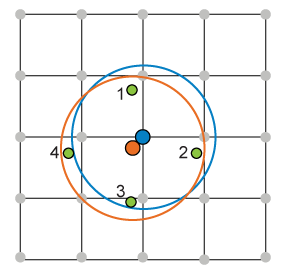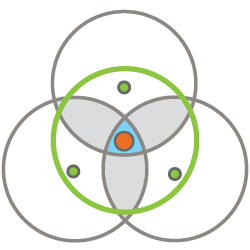Imagine you insure a set of locations spread out over an area. If you take a circle (radius of your choosing) and float it over a map of the region, at which point does it encompass the highest total accumulated exposure value? Stated another way, where is the circle that contains your maximum exposure, and what is that maximum exposure?
This method, often called "ring analysis," is commonly used to monitor aggregations of exposure. Its origin is historical, as it was used as a means of monitoring fire accumulations (fire spread was approximated as being circular). Hence finding this point of maximum exposure could tell an insurer the maximum amount it might lose in any one fire, as captured by a circle of a specified radius.
The technique was also widely adopted in the aftermath of the 9/11 terrorist attack on New York City as a means of monitoring the maximum claim from an explosion at a given location. And it is used today by regulators who, working in the context of Solvency II, for example, ask companies to report their maximum exposure within a 200-meter radius. Similarly, the rating agency A.M. Best requests the insurer's maximum exposure within a 500-foot radius (152m).
Traditionally, this challenge has been approached in a number of ways, most popularly by either running a grid-based analysis by iteratively moving a ring to different points on the grid (grid method) or by placing a ring centered on individual locations and finding the one that encompasses the highest exposure accumulation(location ring method).

Here, four exposure locations are shown by the green dots. The grid-based method identifies the ring centered on the blue dot as the one with maximum exposure,capturing Locations 1, 2, and 3. But the ring centered on the orange dot encompasses all four locations, and was missed by the grid method.
Both methods can easily miss the true ring of maximum exposure,as many in the industry have come to realize, yet they continue to be used for lack of an alternative. However, in Touchstone® version 3.0, which is to be released in summer 2015, AIR offers a more effective approach-one that uses a bottom-up method, using the locations themselves, rather than a top-down approach such as placing a grid over the exposure.
AIR's solution, which we've dubbed Dynamic Ring Analysis,involves placing rings around each location and computing the accumulated results. Where rings intersect, a new ring is placed in the area of intersection of the two rings. If more than two rings intersect, Touchstone determines which areas of intersection should be used and places rings over the centroids of the shapes created by the intersections. Dynamic Ring Analysis, unconstrained by any grid, ensures that the true point of maximum exposure is obtained.

Here, the Dynamic Ring Analysis has identified the ring centered on the red dot as the one with maximum exposure. Note that no grid is needed, and neither does the ring need to be centered on an insured location.
Indeed, in testing, we've observed that Dynamic Ring Analysis routinely outperforms the established grid and location ring methods described above. Dynamic Ring Analysis allows companies to practice more prudent risk management by finding accumulation "hotspots," accurately and efficiently-invaluable for a company's own risk management, for its ratings, and for meeting regulatory requirements.
The video What's New in Touchstone® 3.0: Dynamic RingAnalysis on AIR's YouTube channel explains how the tool works and how it's better than alternative methods.



